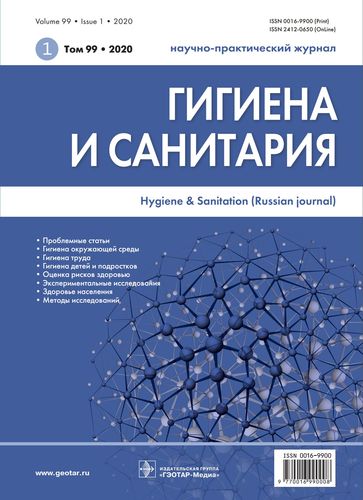The impact of occupational risk factors on the development of lower back pain in industrial workers
- Authors: Shirokov V.A.1, Potaturko A.V.1, Terekhov N.L.1, Solodushkin S.I.2
-
Affiliations:
- Yekaterinburg Medical Research Center for Prophylaxis and Health Protection in Industrial Workers
- First President of Russia B.N. Yeltsin Ural Federal University
- Issue: Vol 99, No 1 (2020)
- Pages: 80-84
- Section: HEALTH RISK ASSESSMENT
- Published: 30.01.2020
- URL: https://edgccjournal.org/0016-9900/article/view/640116
- DOI: https://doi.org/10.47470/0016-9900-2020-99-1-80-84
- ID: 640116
Cite item
Full Text
Abstract
Introduction. Spondylogenic back pain is common in the working-age population and often results in a working disability. In order to ensure professional decision-making and inform preventive measures, occupational risk factors for low back pain (LBP) need to be identified.
Material and methods. Using a regular medical check-up examination data, we analyzed the prevalence and the odds ratio of LBP in 3215 individuals working in physically demanding jobs and exposed to physical inactivity and vibration.
Results. No statistically significant differences in LBP prevalence were found between workers exposed to low total physical activity (PA), in and out of work, and those exposed to physical overwork (38.9% и 33.8% respectively). Physical inactivity in the workplace and hypodynamia during leisure-time cause similar effects and increase the risk of LBP by 1.5 times. A combination of occupational factors such as a constrained posture (class 3.1-3.2 according to the National Labor Legislation) and whole-body vibration increases LBP risk up to 78.7%. Whereas the combination of a constrained posture, prolonged sedentary position, and whole-body vibration, increases LBP prevalence up to 84.21% (OR: 80).
Conclusions. The highest risk of LBP (OR: 80.0) was assigned to the combination of constrained posture, prolonged sedentary position, and whole-body vibration. The obtained data suggest that both low PA and physical overwork increase the risk of LBP, whereas moderate PA reduces it.
About the authors
V. A. Shirokov
Yekaterinburg Medical Research Center for Prophylaxis and Health Protection in Industrial Workers
Author for correspondence.
Email: noemail@neicon.ru
Russian Federation
A. V. Potaturko
Yekaterinburg Medical Research Center for Prophylaxis and Health Protection in Industrial Workers
Email: noemail@neicon.ru
Russian Federation
Nikita L. Terekhov
Yekaterinburg Medical Research Center for Prophylaxis and Health Protection in Industrial Workers
Email: terehovnl@ymrc.ru
Senior researcher, neurologist of the Clinic for Neurology, Yekaterinburg Medical Research Center for Prophylaxis and Health Protection in Industrial Workers, Yekaterinburg, 620014, Russian Federation.
e-mail: terehovnl@ymrc.ru
Russian FederationS. I. Solodushkin
First President of Russia B.N. Yeltsin Ural Federal University
Email: noemail@neicon.ru
Russian Federation
References
- Low Back Pain/Clinical Practice Guidelines Linked to the International Classification of Functioning, Disability, and Health from the Orthopaedic Section of the American Physical Therapy Association. J Orthop Sports Phys Ther. 2012; 42 (4): A1-A57. https://doi.org/10.2519/jospt.2012.0301
- Kremer Yu. Diseases of the intervertebral disc. [Zabolevaniya mezhpozvonkovykh diskov]. Shirokov V.A., ed. Moscow: MEDpress-inform; 2015. 472 p. (in Russian)
- Denisov E.I., Chechalin P.V. Occupationally determined incidence: the basics of methodology. Meditsina truda i promyshlennaya ekologiya [Russian Journal of Occupational Health and Industrial Ecology]. 2006; 8: 5–10. (in Russian)
- Shirokov V.A. Pain is a determinant of occupational diseases of the musculoskeletal system. Rossiyskiy zhurnal boli. 2013; 1: 86. (in Russian)
- Lee N. et al. Perceived discrimination and low back pain among 28,532 workers in South Korea: effect modification by labor union status. Soc Sci Med. 2017; 177: 198–204.
- Farioli A., Mattioli S., Quaglieri A., Curti S., Violante F.S., Coggon D. Musculoskeletal pain in Europe: the role of personal, occupational and social risk factors. Scand J Work Environ Health. 2014; 40 (1): 36–46.
- Shirokov V.A., Goncharenko I.M., Potaturko A.V., Panov V.G., Varaksin A.N. Hypodynamia as a risk factor for pain in the lower back (Proceedings of the XXII Russian scientific-practical conference with international participation “Pain is a disease. From theory to practice”. September 15–17, 2016, Volgograd). Rossiyskiy zhurnal boli. 2016; 2 (50): 63–4 (in Russian)
- Bonde J.P., Jurgensen K.T., Bonzini M., Palmer K.T. Miscarriage and occupational activity: a systematic review and meta-analysis regarding shift work, working hours, lifting, standing and physical workload. Scand J Work Environ Health. 2013; 39 (4): 325–34.
- Lagutina G.N. Risk factors for developing back diseases. In: Occupational health risks for workers. Leadership. [Faktory riska razvitiya bolezney spiny. V kn.: Professional’nyy risk dlya zdorov’ya rabotnikov. Rukovodstvo]. Izmerov N.F., Denisov E.I., eds. Moscow: Trovant; 2003: 315–20. (in Russian)
- Andersen J.H., Haahr J.P., Frost P. Details on the association between heavy lifting and low back pain. Spine J. 2011; 11 (7): 690–1.
- Plouvier S., Chastang J.F., Cyr D., Bonenfant S., Descatha A. et al. Occupational biomechanical exposure predicts low back pain in older age among men in the Gazel Cohort. Int Arch Occup Environ Health. 2015; 8 (4): 501–10.
- Burström L., Nilsson T., Wahlström J. Whole-body vibration and the risk of low back pain and sciatica: a systematic review and meta-analysis. Intern Arch Occup Environ Health. 2015; 88 (4): 403–18.
- Ghaffari M. et al. Effect of psychosocial factors on low back pain in industrial workers. Occup Med (Lond). 2008; 58: 341–7.
- Shirokov V.A., Potaturko A.V., Varaksin A.V. To the problem of clinical and epidemiological substantiation of professional etiology of lower lumbar pain. Meditsina truda i promyshlennaya ekologiya [Russian Journal of Occupational Health and Industrial Ecology]. 2017; 9: 221–2. (in Russian)
- Hagstromer M., Oja1 P., Sjostrom M. The International Physical Activity Questionnaire (IPAQ): a study of concurrent and construct validity. Public Health Nutr. 2005; 9 (6): 755–62. https://doi.org/10.1079/PHN2005898
- Rosenthal J. Qualitative descriptors of strength of association and effect size. J Soc Serv Res. 1996; 21: 37–59.
Supplementary files









